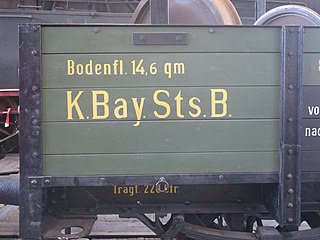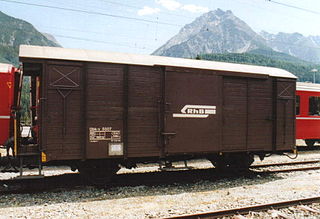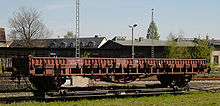
The Deutsche Reichsbahn, also known as the German National Railway, the German State Railway, German Reich Railway, and the German Imperial Railway, was the German national railway system created after the end of World War I from the regional railways of the individual states of the German Empire. The Deutsche Reichsbahn has been described as "the largest enterprise in the capitalist world in the years between 1920 and 1932"; nevertheless, its importance "arises primarily from the fact that the Reichsbahn was at the center of events in a period of great turmoil in German history".

The Royal Bavarian State Railways was the state railway company for the Kingdom of Bavaria. It was founded in 1844. The organisation grew into the second largest of the German state railways with a railway network of 8,526 kilometres by the end of the First World War.

Bavarian branch lines comprised nearly half the total railway network in Bavaria, a state in the southeastern Germany that was a kingdom in the days of the German Empire. The construction era for branch lines lasted from 1872, when the first route, from Siegelsdorf to Langenzenn, was opened, to 1930, when the last section of the branch from Gößweinstein to Behringersmühle went operational.

The Einheitsdampflokomotiven, sometimes shortened to Einheitslokomotiven or Einheitsloks, were the standardized steam locomotives built in Germany after 1925 under the direction of the Deutsche Reichsbahn-Gesellschaft. Their manufacture made extensive use of standard design features and components.

The German term Verbandsbauart describes both a type of goods wagon as well as a type of tram.

Goods wagons or freight wagons, also known as goods carriages, goods trucks, freight carriages or freight trucks, are unpowered railway vehicles that are used for the transportation of cargo. A variety of wagon types are in use to handle different types of goods, but all goods wagons in a regional network typically have standardized couplers and other fittings, such as hoses for air brakes, allowing different wagon types to be assembled into trains. For tracking and identification purposes, goods wagons are generally assigned a unique identifier, typically a UIC wagon number, or in North America, a company reporting mark plus a company specific serial number.

The system of German railway wagon classes (Wagengattungen) was introduced in Germany in 1902 and 1905 by the Prussian state railways based on their system of norms, and was soon taken up by the other state railways (Länderbahnen). On the formation of the Deutsche Reichsbahn, the system became mandatory across the whole of Germany. In the course of the years more and more adjustments to it were made. It was finally replaced between 1964 and 1968 when the two German railway administrations - the Deutsche Bundesbahn and the Deutsche Reichsbahn - adopted the internationally standard UIC classifications for passenger coaches and goods wagons. Today, the system is still regularly being used for narrow gauge goods wagons, because these were not generally given UIC designations, as well as on many historical vehicles.
The Royal Bavarian State Railways had, at different times, three different goods wagon classification systems that roughly correspond to the early, middle and late period of the state railway era in Bavaria:
The so-called Austauschbauart wagons were German railway vehicles produced from the late 1920s onwards which had common components built to agreed standards.

The German term Donnerbüchse means "thunderbox" and is the nickname for the four-wheeled, open, passenger coaches, built from 1921 onwards, that served with the Deutsche Reichsbahn. In contrast to their predecessors, they were made entirely of iron or steel. The name comes from the loud rumbling of these coaches as a result of their lack of damping. Even the immediate forerunners of these wagons were given the name despite their wooden construction. In the early days, they were also called Ackermann'sche Donnerbüchse after the departmental head responsible for them in the Ministry of Transport.
In German railway engineering, norms (Normalien) are standards for the design and production of railway vehicles. In the 1880s and 1890s, Prussian norms were developed for the locomotives, tenders and wagons of the Prussian state railways under the direction of the railway director responsible for railway engineering, Moritz Stambke. Later, these were largely adopted by the other state railways (Länderbahnen) in Germany.

Open wagons form a large group of railway goods wagons designed primarily for the transportation of bulk goods that are not moisture-retentive and can usually be tipped, dumped or shovelled. The International Union of Railways (UIC) distinguishes between ordinary wagons and special wagons (F/6). Open wagons often form a significant part of a railway company's goods wagon fleet; for example, forming just under 40% of the Deutsche Bahn's total goods wagon stock in Germany.

Flat wagons, as classified by the International Union of Railways (UIC), are railway goods wagons that have a flat, usually full-length, deck and little or no superstructure. By contrast, open wagons have high side and end walls and covered goods wagons have a fixed roof and sides. Flat wagons are often designed for the transportation of goods that are not weather-sensitive. Some flat wagons are able to be covered completely by tarpaulins or hoods and are therefore suitable for the transport of weather-sensitive goods. Unlike a "goods wagon with opening roof", the loading area of a flat is entirely open and accessible once the cover is removed.

A covered goods wagon or covered goods van is a railway goods wagon which is designed for the transportation of moisture-susceptible goods and therefore fully enclosed by sides and a fixed roof. They are often referred to simply as covered wagons, and this is the term used by the International Union of Railways (UIC). Since the introduction of the international classification for goods wagons by the UIC in the 1960s a distinction has been drawn between ordinary and special covered wagons. Other types of wagon, such as refrigerated vans and goods wagons with opening roofs, are closely related to covered wagons from a design point of view. Similar freight cars in North America are called boxcars.
The covered goods wagons of classes Glrhs Dresden and Gltrhs Dresden were first placed in service in Germany by the Deutsche Reichsbahn-Gesellschaft in 1937. The wartime (Kriegsbauart) wagon, the DRB Glmhs Leipzig, and the wartime passenger wagon, the DRB MCi-43, were based on the Dresden classes.
The International Union of Railways groups all special classes of railway goods wagon into Class U in its goods wagon classification system.
The wagon with opening roof is a type of railway goods wagon that is, nowadays, defined and standardised by the International Union of Railways (UIC) as Class "T". They are a large category of rail vehicle, predominantly used for the transport of hygroscopic bulk commodities such as cement, plaster, lime, potash and grain.
A cattle wagon or a livestock wagon is a type of railway vehicle designed to carry livestock. Within the classification system of the International Union of Railways they fall under Class H - special covered wagons - which, in turn are part of the group of covered goods wagons, although cattle have historically also been transported in open goods wagons. The American equivalent is called a stock car.
Goods wagons of welded construction were developed and built by the Deutsche Reichsbahn in Germany from 1933 to about 1945. With the introduction of welding technology in 1933 almost all wagon components were joined by welding and no longer by rivetting. This enabled goods wagons to be designed, for example, for higher speeds or for higher payloads through the use of different types of steel and other engineering changes, but their further development was so heavily influenced by the exigencies of the Second World War that, as early as 1939, the Deutsche Reichsbahn had to temper the design of goods wagons to the new economic circumstances. Because there were overlaps in the change from the Austauschbauart - goods wagons made with interchangeable components - to the new welded classes, the period of the changeover cannot be exactly defined. Several standard goods wagons and their classes are covered in other articles. Goods wagons built during the Second World War that were purely intended for military transport use, are covered under the article on Kriegsbauart - wartime classes.

Class districts were a classification system for railway goods wagons used by the Deutsche Reichsbahn (1920–1945) in Germany between the wars.












